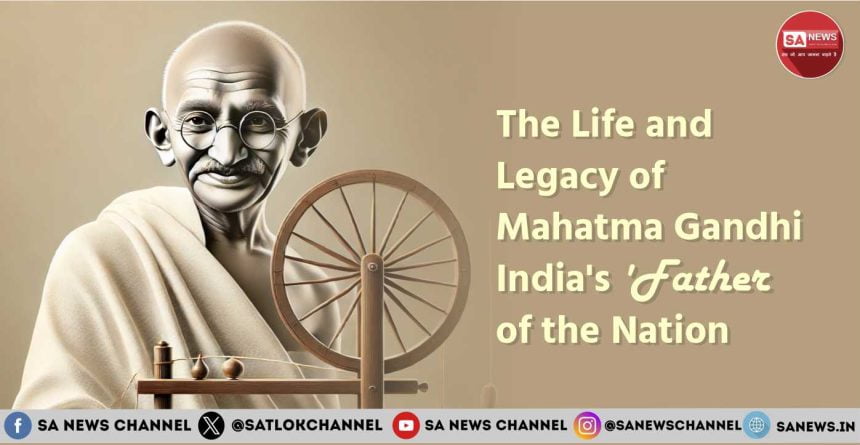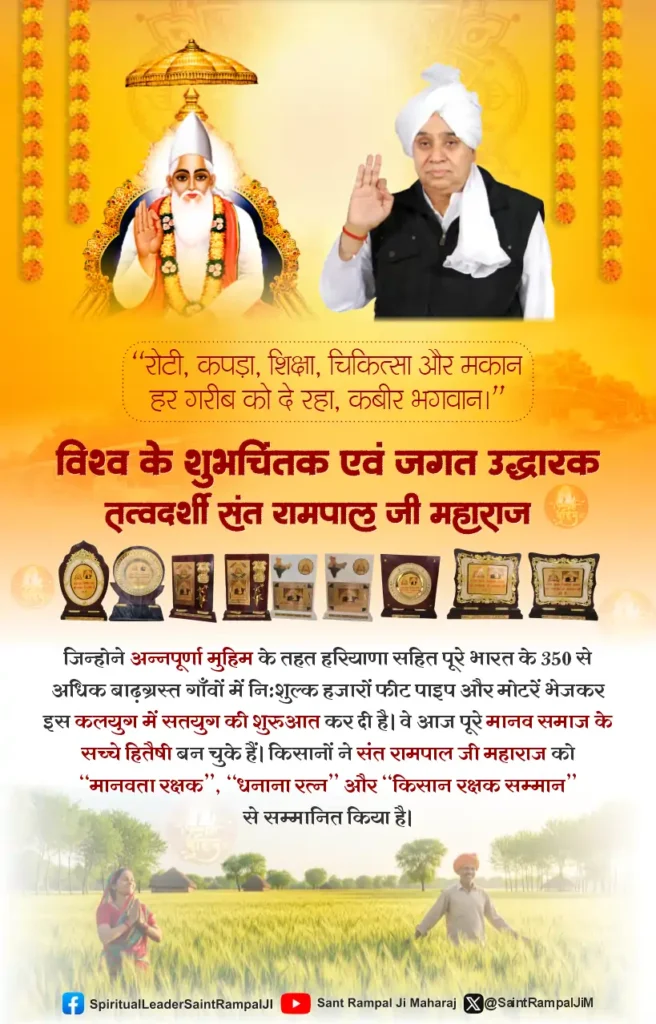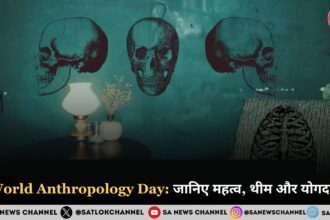This biography delves us into the life and times of Mahatma Gandhi, exploring his early years, his political awakening, and his remarkable leadership in the fight for Indian independence. It also examines his philosophy, principles, and personal life, revealing the complexities and nuances in the life of this extraordinary individual. Let’s start reading about a true hero of modern history, and his continued relevance in today’s world.
- Early Life of Mahatma Gandhi
- Gandhi’s Powerful writing Legacy
- Some of his Notable Works Include
- Political Awakening
- Mahatma Gandhi’s Closest Allies
- Indian Independence Movement
- The Key Movements and Events of Mahatma Gandhi
- Mahatma Gandhi’s Philosophy and Principles
- The spiritual legacy of Saint Rampal Ji Maharaj weaves Humanity back Together
- FAQs about Mahatma Gandhi
- Q1: What is Mahatma Gandhi’s birthdate?
- Q2: What was the name of Gandhi’s philosophy of non-violent resistance?
- Q3: What was the significance of the Salt March in Gandhi’s movement?
- Q4: Who assassinated Mahatma Gandhi?
- Q5: What is the name of the movement led by Gandhi to free India from British rule?
- Connect With Us on the Following Social Media Platforms
Mahatma Gandhi (1869-1948) was a visionary leader, a champion of non-violent resistance, and a leader of hope for India’s struggle for independence. Born in Porbandar, Gujarat, India, Gandhi’s life was a legacy to the power of simplicity, compassion, and unwavering dedication to truth. With a strong sense of justice and a willingness to challenge authority, Gandhi’s journey took him from being a young lawyer in South Africa to becoming the leader of India’s freedom movement.
His philosophy of Satyagraha (truth force) and Ahinsa (non-violence) inspired a nation to rise up against British colonial rule, paving the way for India’s independence in 1947.
Gandhi’s impact extends far beyond India’s borders, influencing civil rights movements worldwide and shaping the course of modern history. His legacy continues to inspire leaders, activists, and individuals around the globe, offering a powerful reminder of the transformative potential of non-violent resistance and the importance of living a simple, selfless life.
Early Life of Mahatma Gandhi
Gandhi was born on October 2, 1869, in Porbandar, Gujarat, India, to Karamchand Gandhi and Putlibai Gandhi. He was the youngest of four children. His family was devoutly Hindu and followed the Vaishnavite tradition.
Education and influences: Gandhi studied law at the University of Bombay and later at the Inns of Court School of Law in London. He was influenced by thinkers like Henry David Thoreau, Leo Tolstoy, and John Ruskin.
Mahatma Gandhi’s personal life was marked by simplicity, devotion, and a deep commitment to his family and spiritual beliefs. In 1883, he married Kasturba Gandhi, a union that lasted for over 60 years until her passing in 1944. Together, they had four sons, Harilal, Manilal, Ramdas, and Devdas. Gandhi’s family life was deeply influenced by his spiritual practices, including his adherence to Hinduism and his belief in the power of non-violence and self-discipline.
He was also drawn to other spiritual traditions, including Jainism and Christianity, and incorporated elements of these into his daily life. Gandhi’s spiritual practices included meditation, prayer, and fasting, which he believed helped him cultivate inner peace and guidance. Despite the demands of his public life, Gandhi prioritized his family and spiritual growth, recognizing that a strong foundation in these areas was essential to his work as a leader and social reformer.
Gandhi’s Powerful writing Legacy
Mahatma Gandhi was a prolific writer, and his extensive writings offer valuable insights into his philosophy of non-violence, self-belief, and political ideology. His literary legacy includes numerous books, essays, letters, and notable works, which have been compiled into 100 volumes.
One of his most famous works is “My Experiments with Truth”, a deeply personal and reflective memoir that chronicles his journey towards developing his ethical and political beliefs. Another seminal work is “Hind Swaraj”, which outlines his vision for Indian self-rule and independence from British colonialism.
Gandhi’s writings are a testament to his intellectual curiosity, moral courage, and commitment to truth. Through his words, he continues to inspire and influence generations of thinkers, activists, and leaders. His literary output is a treasure trove of wisdom, offering guidance on non-violent resistance, simple living, and the pursuit of truth and justice.
Some of his Notable Works Include
- “My Experiments with Truth” (1925-1929)
- “Hind Swaraj” (1909)
- “Satyagraha in South Africa” (1928)
- “Constructive Programme: Its Meaning and Place” (1941)
- “India of My Dreams” (1948)
Gandhi’s writings remain a powerful legacy, offering insights into his life, philosophy, and vision for a better world.
Political Awakening
Experiences in South Africa: In 1893, Gandhi moved to South Africa, where he faced racism and discrimination. He was thrown off a train for refusing to move from the first-class compartment, sparking his fight for justice and equality.
Fight against racism and discrimination: Gandhi organized the Indian community in South Africa, leading protests and petitions against discriminatory laws. He developed the concept of Satyagraha (truth force) during this time.
Mahatma Gandhi’s Closest Allies
Mahatma Gandhi was surrounded by a circle of close Indian friends and associates who played important roles in his life and the Indian independence movement. These included Jawaharlal Nehru, who later became India’s first Prime Minister, and Sardar Vallabhbhai Patel, a trusted friend and colleague.
Other notable friends were Subhas Chandra Bose, who led the Indian National Army, and Lala Lajpat Rai, a mentor and friend who was a prominent leader in the independence movement.
Gandhi was also close to literary figures like Rabindranath Tagore, a Nobel laureate and renowned poet, and Sarojini Naidu, a poet and political activist. Additionally, he had strong friendships with political leaders like C. Rajagopalachari, Khan Abdul Ghaffar Khan, J.B. Kripalani, and Madan Mohan Malaviya, who shared his vision for a free and self-sufficient India. Together, they formed a diverse network of friends and allies who supported Gandhi in his quest for Indian independence and social reform.
Indian Independence Movement
- Return to India and involvement in the freedom struggle: Gandhi returned to India in 1915 and joined the Indian National Congress. He became a key figure in the fight for independence from British rule.
- Non-violent resistance and civil disobedience: Gandhi led several movements, including the Non-Cooperation Movement, Salt March, and Quit India Movement, using non-violent resistance and civil disobedience to challenge British authority.
- Leadership and legacy: Gandhi’s leadership and legacy extended beyond India, inspiring global leaders like Martin Luther King Jr. and Nelson Mandela.
- Assassination and aftermath: Gandhi was assassinated on January 30, 1948, by Nathuram Godse. His death led to widespread mourning and solidified his legacy as a national hero.
Gandhi developed the concept of Satyagraha (truth force) and Ahinsa (non-violence) as the core of his resistance movement. He led several movements, including:
- Non-Cooperation Movement (1920-1922): boycotting British goods, law courts, and government institutions.
- Salt March (1930): Marching 240 miles to protest the salt tax and British monopoly on salt production.
- Quit India Movement (1942): Demanding immediate independence and an end to British rule.
- He used civil disobedience, non-violent protests, and non-cooperation to challenge British authority.
- He was arrested several times, but continued to advocate for non-violent resistance and inspire others to join the movement.
The Key Movements and Events of Mahatma Gandhi
Gandhi’s leadership and philosophy played a crucial role in shaping India’s independence movement and inspiring future generations of leaders and activists.
- Champaran Satyagraha (1917): Gandhi’s first major movement in India, advocating for farmers’ rights.
- Kheda Satyagraha (1918): Gandhi led a successful movement for farmers’ rights and tax relief.
- Jallianwala Bagh Massacre (1919): a brutal British response to peaceful protests, which Gandhi condemned.
- Round Table Conferences (1930-1932): Gandhi attended conferences in London to negotiate Indian independence.
- Non-Cooperation Movement (1920-1922): Gandhi led a nationwide movement to boycott British goods, law courts, and government institutions. The movement aimed to resist British rule and promote Indian self-rule.
- Salt March (1930): Gandhi marched 240 miles from Ahmedabad to Dandi to protest the salt tax and British monopoly on salt production. The march sparked widespread protests and civil disobedience across India.
- Quit India Movement (1942): Gandhi demanded immediate independence and an end to British rule. The movement was marked by widespread protests, strikes, and civil disobedience, but was ultimately suppressed by the British.
Mahatma Gandhi’s Philosophy and Principles
- Ahinsa (Non-Violence): Gandhi believed in the power of non-violence and compassion to bring about social change. He advocated for peaceful resistance and non-violent civil disobedience.
- Satyagraha (Truth Force): Gandhi developed the concept of Satyagraha, which emphasizes the power of truth and non-violent resistance to challenge unjust laws and authority.
- Simple Living and Self-Sufficiency: Gandhi advocated for a simple, self-sufficient lifestyle, free from material possessions and desires. He believed in living in harmony with nature and promoting local industries and self-reliance.
- Swaraj (Self-Rule): Gandhi believed in the importance of self-rule and Indian independence from British colonial rule.
- Civil Disobedience: Gandhi advocated for non-violent civil disobedience as a means to challenge unjust laws and authority.
- Non-Possessiveness: Gandhi believed in living simply and free from material possessions.
- Brahmacharya (Celibacy): Gandhi believed in the importance of celibacy and self-control.
- Sarvodaya (Welfare of All): Gandhi believed in the importance of promoting the welfare of all people, regardless of caste, creed, or religion.
- Hindu Scriptures: Gandhi studied the Bhagavad Gita, the Upanishads, and other Hindu texts, which shaped his understanding of non-violence, self-discipline, and self-realization.
- Vegetarianism: He adopted a vegetarian diet, believing it was a more compassionate and healthy choice. His life and legacy continue to inspire and influence people around the world.
The spiritual legacy of Saint Rampal Ji Maharaj weaves Humanity back Together
In the midst of life’s trials and tribulations, the teachings of Sant Rampal Ji Maharaj offer a beacon of hope and a path to true inner peace. Sant Rampal Ji’s spiritual teachings emphasize the importance of living a life of Ahinsa, or non-violence, which begins with self-purification and compassion.
He encourages seekers to embrace Truth as the highest religion, seeking it within themselves to find God. Through self-discipline and simplicity, one can unlock spiritual growth, letting go of desires and worldly attachments. Love and compassion are the keys to conquering evil, and selfless service to humanity is the ultimate service to God.
By being the change we wish to see in the world and embodying spiritual values in our actions, we can attain inner peace and enlightenment. Saint Rampal Ji’s teachings align with Gandhi’s principles, inspiring individuals to embark on a journey of inner transformation, self-realization, and devotion to the divine.
To understand the spiritual knowledge thoroughly please visit our website www.jagatgururampalji.org
FAQs about Mahatma Gandhi
Q1: What is Mahatma Gandhi’s birthdate?
A1: Mahatma Gandhi was born on October 2, 1869.
Q2: What was the name of Gandhi’s philosophy of non-violent resistance?
A2: Gandhi’s philosophy was called Satyagraha, which translates to “truth force” or “soul force.”
Q3: What was the significance of the Salt March in Gandhi’s movement?
A3: The Salt March, also known as the Dandi March, was a 24-day walk led by Gandhi to protest the British salt tax, symbolizing resistance against British rule and inspiring widespread civil disobedience.
Q4: Who assassinated Mahatma Gandhi?
A4: Mahatma Gandhi was assassinated by Nathuram Godse, a Hindu nationalist, on January 30, 1948.
Q5: What is the name of the movement led by Gandhi to free India from British rule?
A5: The movement led by Gandhi was called the Indian Independence Movement or the Quit India Movement.









